7 Best Product Roadmap Tools in 2024
Let’s start with that date there – 2024. Those of us who remember the 90s can’t help but hear that and think the future. It’s 2024 people! Can you believe it? While we might not have hover boards yet (seriously, how long do we have to wait?), we do have a very different kind of Product Management. Product Management in 2024 and beyond is about driving commercially meaningful outcomes rather than simply delivering outputs. In order to survive and thrive in this future state, you need to know the best product roadmap tools to help you keep up with modern approaches to managing products.
Because, my product-minded friends, the days of building features for the sake of shipping something are long gone – as Product Managers today, you need to focus on aligning your roadmap with overall company goals, ensuring that every step forward with the product development is a step toward measurable business growth.
Am I right? Or am I right? Product as a department and a discipline is about growth. We are a growth function occupied with strategic planning and execution of business-critical activities.
You need the best product roadmap tools to make that happen. Your chosen tool needs to be about so much more than managing tasks; it needs to help you stay on track with your vision, keep everyone aligned, and prove the results you’re driving.
In this article, we’ll explore the seven best product roadmap tools in 2024 and assess each on how well they help you not just deliver, but deliver impact. From making sure your product strategy is linked to business outcomes to giving your team the flexibility they need to pivot when needed, the right tool can be the growth driver your product management strategy deserves.
We will cover:
- What are product roadmap tools?
- Why use product roadmap tools?
- Key features of the best product roadmap tools
- What are the alternatives to product roadmap tools?
- What are the benefits of purpose-built product roadmap tools?
- Key considerations for choosing from the best product roadmap tools
- The best product roadmap tools
So, let’s dive into the seven best product roadmap tools you should be considering in 2024 and how they can help you stay outcome-focused.
What are product roadmap tools?
I’m going to assume you all know what a product roadmap is. Of course you do. You know you need a roadmap, you’re looking for the right tool to help you manage it. For anyone looking for clarity on what a product roadmap is just check out our Ultimate Guide to Product Roadmaps.
But we’re here to talk about tools.
Product roadmap tools are designed to help Product Teams plan, communicate, and track their product strategy. They give you a clear visual of where your product is heading and how you’ll get there. But the best product roadmap tools go beyond just listing out features or release dates – they help connect your product strategy to your business goals and provide clear evidence to your stakeholders of why you have made the roadmapping decisions you have.
The best product roadmap tools help you communicate a roadmap that effectively answers questions like:
- How does this initiative align with our objectives?
- What customer problems are we solving with this update?
- What outcomes have we driven with each completed initiative?
- What stage of the development process is each initiative at?
- Why has this initiative been prioritized over others?
- What different ideas have we explored for each problem area?
- How do we know the chosen idea is likely to be the best solution?
In short, the best product roadmap tools help you shift from feature factory mode into a more strategic approach, ensuring your team is working on the right things for the right reasons.
The best product roadmap tools don’t just help you communicate your strategic priorities in such a way that adds transparency to your decision-making process – although they certainly should do that. The best product roadmap tools also provide you with all the features and functionality to help you actually make those decisions, and then act on them.
The best product roadmap tools will also help you:
- Prioritize your idea backlog to help you find candidates for your roadmap
- Link to your customer feedback so you can be sure you’re solving the right problems
- Speed up your ideation with AI assistance
- Generate supporting documentation
- Collaborate with your teammates and stakeholders across your organization
- Capture all your product work and decision logs in one centralized place
Why use product roadmap tools?
Do you have to use a specific tool for your product roadmap? Can you not just draw it up on a piece of paper and be done with it? No. No you can’t.
Because in Product Management, alignment is everything. The best product roadmap tools make sure everyone – from the developers to the executives to your customers – has a live and dynamic view of not just what you’re building, but why you’re building it. These tools give you a clear, shareable view of what’s in the pipeline and how it ties back to your broader business goals.
A piece of paper on your desk doesn’t give anyone else visibility into your product strategy and progress. If your roadmap is not in an easily accessible and dynamic format, you’re going to spend every waking moment having to answer questions from stakeholders and teammates who have zero visibility of what is happening and why.
Also, if your product roadmap is sitting there on that bit of paper, isolated and lonely on your desk, how often do you think you’ll be looking at it?
Without your roadmap in a product roadmap tool – a central product tool in which you do most of your work – it’s easy to get caught up in the day-to-day grind and lose sight of that bigger picture plan. Before you know it, you’re a Project Manager pushing through features and not a strategically focused Product Manager delivering impact.
Key features of the best product roadmap tools
What should you expect from the best product roadmap tools? If you’re going out shopping for a roadmap tool, what’s on your must-have list? Let’s start with the minimum requirements and then list out the features you can expect from the very best product roadmap tools.
The best product roadmap tools should have:
- Dynamic, interactive roadmaps
- Customizable roadmap views that let you create different versions with different levels of detail
- The ability to publish versions of your roadmap externally
- Integrations with the tools your wider organization use
- Connection to your customer feedback
- Collaboration tools
- Integration with your product management workflow
- Connection to your idea backlog
The VERY best product roadmap tools will also have:
- Outcome-based roadmaps
- A hierarchy that enables you to stay flexible, work in an agile way and declare the problem to solve, not specific features
- AI assistance to help you work faster and smarter
- OKR management to keep you laser focused on driving outcomes
- Portfolio management and the ability to scale if your needs increase
- Collaboration tools that do not require stakeholders to log into the product roadmap tool, but add their contribution from the tools they already use
Want to explore a product roadmap tool that has ALL these features?
Jump inside our product roadmap template found in our free-to-use Sandbox. Here you can see a quality roadmap in action, and learn how to build one for yourself in ProdPad. Our product roadmap template is dynamic, not static, helping you to really understand our product roadmap tool.

What are the alternatives to product roadmap tools?
Spreadsheets and slide decks
We’ve already discussed the piece of paper. But surely no one would actually do that with their roadmap?! Some Product Managers, however, do use spreadsheets, slide decks and document files for their roadmaps.
I know. Why would you ever do that?
Spreadsheets, slide decks and documents are often static files, saved on a drive somewhere. They’re not dynamic and always up to date. The problems with this are extensive. You’ll be faced with endless versioning headaches and you can’t ever be confident everyone is looking at the most up-to-date version. You’ll have huge admin overheads, having to manually update your roadmap document all the time. You’ll end up having to repeatedly remind people where they can see the roadmap because no one ever remembers different filing systems or where something is saved.
Even if you keep your spreadsheet or slide deck in the cloud and manage to remove the versioning headaches, how inspiring is a spreadsheet or presentation file ever going to be? There are better ways to visualize your product roadmap so people actually understand what they are looking at.
A product roadmap confined to a spreadsheet or similar document is also completely detached from everything else! Where’s the link to your customer feedback, your backlog, your release planning, your design files? This makes it extremely hard to keep your roadmap at the heart of everything you do. Increasing the risk of ‘everything you do’ becoming detached from the strategic plan. Which is when you start slipping into an output mindset instead of delivering outcomes.
So, in sum, don’t use general tools like spreadsheets, slide decks or document files.
Project management tools
But what about those generalist productivity tools that are designed to help you manage tasks and track projects? Are they an option?
I mean, sure, maybe if you’re just getting started and have no budget for a proper product tool. If you want to have an initial stab at creating a roadmap in a dynamic tool and you already have a license for something like ClickUp, Asana, Trello, or monday.com then sure, give it a go. But, be aware of the limitations.
Remember, a product roadmap isn’t a project plan, it’s a strategic communication tool. Don’t forget the distinction between a product roadmap and a delivery or release plan – don’t get them confused or try to solve both problems with one tool. If you use a tool designed for task management for your product roadmap, you can very easily fall into the trap of presenting your stakeholders with a timeline project plan Gantt chart instead of a high level strategic plan.
The other option some Product Managers will try is using whiteboard tools or wiki software. Although they can offer better visualization capabilities than project management tools or the dreaded spreadsheet, they lack the connection to your execution workflow.
You need the best of both worlds – an easy-to-understand visualization of a bigger picture strategic plan, alongside the ability to drill down if needed and follow a thread all the way through to the detailed release plans.
This is why purpose-built product roadmap tools exist.
What are the benefits of purpose-built product roadmap tools?
The biggest advantage of using one of the best product roadmap tools, specifically designed for product teams and roadmapping requirements? The help it gives you to work in line with modern Product Management best practice.
Work within best practices
If you use a purpose-built product roadmap tool you should (assuming you’ve picked one of the best ones) find a structure and a bunch of built-in features that guide your process, behaviors and even the wider organization towards proven best ways of working.
Not least of all will be the connection to objectives and key business goals. Because, as we’ve already said, the very best product roadmap tools will help you stay laser-focused on outcomes. You’ll have far better:
- Strategic alignment: Your roadmap will be clearly tied to your product strategy and business objectives.
- Clarity of communication: Everyone can see what’s coming up and how it fits into the bigger picture.
- Adaptability: As priorities shift, your roadmap will be able to keep up. The right tool will allow you to make updates without losing sight of your overall goals.
- Stakeholder visibility: Get buy-in from execs and other departments by showing how your roadmap connects to business growth.
Move faster
You’ll also be able to move a lot faster. Everything is set up specifically for the requirements of a Product Team, so you won’t need to get your head around how to bend and adapt a generalist tool to fit your use case.
You’ll have ready-made product roadmap templates right off the bat, you’ll have suggested workflow stages already created, you’ll have default filters and suggested roadmap views ready to share.
Key Considerations for choosing from the best product roadmap tools
So, now you understand what product roadmap tools are and what makes purpose-built tools like this the best option. But you’ll still need to narrow down a fairly long list to find the best product roadmap tool for you. How do you decide?
There are a number of questions you need to ask yourself.
Are you outcome-focused?
This has to be question number one. What does your business value most? Is it more important that you can demonstrate volume of features or improved metrics and results? Hopefully you’ll be answering in favor of outcomes and results. If you’re not, you may need to have a word with your senior stakeholders and help them see the light about the importance of outcome-based roadmapping. We’ve got a ready-made presentation deck you can use for the job! See below 👇

If you can confidently say that outcomes are your key focus, then you need a product roadmap tool that allows you to run an agile-friendly Now-Next-Later product roadmap. If you need to know more about the time-horizon-based roadmap format (the antithesis of the timeline roadmap), we have you covered.
Do you want to foster a product culture across your organization?
Is part of your objective for revamping your roadmap and how you communicate it, to help promote a ‘product mindset’ across the company? Do you want to get more stakeholders engaged with the product process in the hope that you’ll convince them of the alignment, strategic importance and success of the Product? Are you hoping to encourage collaboration from other teams and stakeholders so there is more transparency on how you work, how you reach decisions and why you have to balance priorities and sometimes say no?
If so, look for a tool that has the most robust publishing and sharing options, the right collaboration integrations and the clearest visualization of why things are where they are on your roadmap.
Also look for a tool that will allow you to add everyone in your organization as a collaborator for free. And make sure you understand what they can do as a ‘collaborator’ or ‘reviewer’ or ‘contributor’ or whatever the user type is called. Can they only view? Or have they got the ability to submit feedback, add comments, join in discussions or even submit ideas to your roadmap initiatives? Spoiler alert – free reviewer accounts can do all that and more in ProdPad.
Do you need your tool to play nicely with other tools in your organization?
If you answered yes to the previous question then you’ll definitely need to consider this. The whole point of using one of the best product roadmap tools is so you don’t have a roadmap that sits in isolation from everything else. So think about how you need your chosen tool to integrate with your existing systems.
Think about…
- Where your developers manage their sprint planning
- Which CRM your Sales Team uses
- The Customer Support tools your customer-facing teams use
- The messaging app your wider organization favors
What does the future of your team look like?
You don’t want to be back here in a year’s time looking for a new tool because your chosen one isn’t able to scale with you. So consider if you’ll be likely to add new products or new product lines and will need to manage a portfolio or even multiple portfolios.
Also consider all the security implications of a growing team. Look out for the right type of Single Sign On capabilities and security compliance.
The best product roadmap tools
OK, full disclosure, you’re on the ProdPad blog so you can guess which tool is top of the list. Yes we obviously have a degree of bias 😬, but we seriously do stand by all the reasons why ProdPad is the best product roadmap tool for forward-thinking Product Managers.
Having said that, we’re not about to start bad mouthing our competitors all over town. That’s not our style. We’re all product people building tools for product people, after all. And some of these folks have built some really great software tools, with some solid features that have given us food for thought over the years.
We’ve included the tools we believe are the absolute best suited for product roadmapping – they are all purpose-built and all have a proven track record as an established player in the market.
So let’s delve in….
1. ProdPad
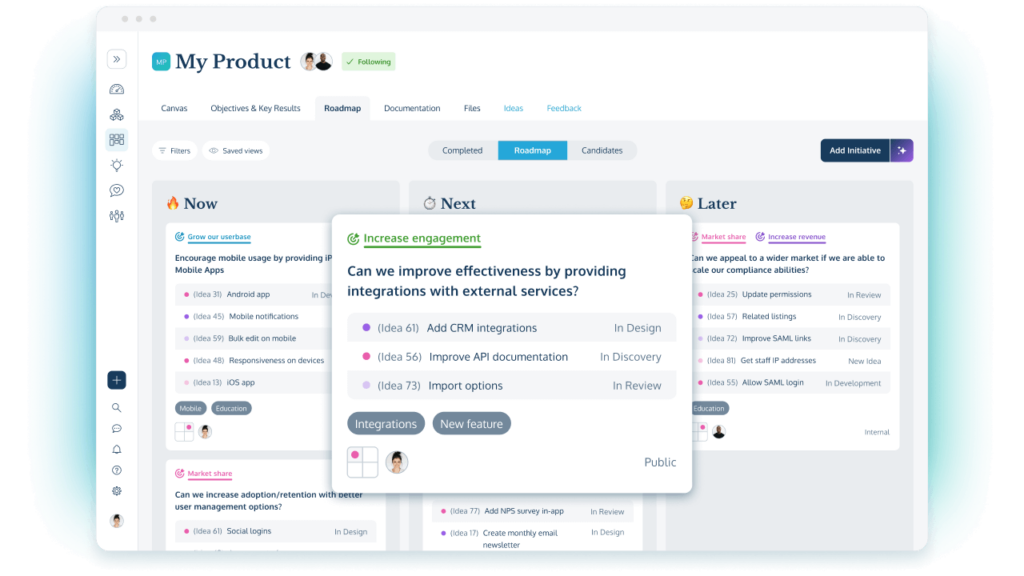
Who is it for?
ProdPad is the best product roadmap tool for outcome-focused Product Teams of any size. ProdPad is structured around the industry-prefered Now-Next-Later roadmap format which was actually invented by our very own Co-Founders and allows Product Managers to present a roadmap that follows an Initiative > Idea structure.
This two level structure to roadmap items is the key to staying flexible and working in an agile way. Instead of pinning exact features to your roadmap from the start, with ProdPad you create roadmap Initiatives that are focused on a problem to solve. You then attach various different Ideas to each Initiative as your thinking develops, working each through discovery until you find the best solution to the problem you have prioritized.
This also makes ProdPad the best product roadmap tool for PMs looking to communicate their roadmap in a way that does not create stakeholder expectations tied to arbitrary dates. ProdPad’s roadmap flexibility provides stakeholders with a clear picture of the product priorities, with broad time horizons for the stuff that is further out, moving to more exact time periods as Initiatives move further down the line.
In this way, Product Teams spend less time reworking their roadmap when discovery work invalidates one Idea and means changing to a different feature Idea. They can stay true to a roadmap that is agile, flexible and focused on the outcomes they want to drive, not exact feature outputs.
Whether you’re in a startup or an enterprise, ProdPad’s flexibility and emphasis on strategic alignment make it the go-to tool for teams that refuse to compromise on quality or clarity.
Best features – ‘The Pros’
- Outcome-driven roadmapping: Unlike most tools that focus on features and timelines, ProdPad helps you build roadmaps based on business outcomes and customer needs. All Initiatives are linked to Objectives and the whole roadmap can be viewed by Objectives. Each roadmap item includes a space for you to capture target outcomes and record release outcomes. You even get a unique Completed view of your roadmap so you can easily demonstrate your outcomes to stakeholders.
- OKR management: ProdPad’s product roadmapping tool comes complete with a full OKR management system that allows you to set, manage and track general objectives and specific goals. Importantly you can then link each Initiative on your roadmap with the particular Objective and Key Result it seeks to achieve.
- Strategy canvas: Another unique feature of ProdPad. For each portfolio, product line and individual product there is a CAnvas to record and develop the product vision, value, positioning and more. This gives PMs a flexible space in which to document the broad strategy, stored next to the roadmap so no one loses sight of the bigger picture.
- Integrated customer feedback: Part of a complete product management platform, ProdPad also collects, organizes, and prioritizes your customer feedback, meaning you can link your evidence directly to your roadmap to support your decision-making.
- AI Assistance: ProdPad also has the best and most mature AI capabilities of any other tool on this list. ProdPad has been able to automatically de-dupe your backlog for many years, but with new AI features being released every week the tool is even further ahead of competitors. Honestly, the AI is game-changing.
- Collaboration-ready: ProdPad’s product roadmap tool is specifically designed to foster communication and alignment across teams. It comes complete with, for example, the most robust Slack and Teams integrations of all the tools on this list. This means anyone in your organization can contribute and comment on your roadmap and its Initiatives from the safety of the tools they already use day-in, day-out.
- Prioritization tools: ProdPad has built-in prioritization tools like our Prioritization chart which makes it quick and easy to spot the Ideas and Initiatives that will deliver the most impact relative to the effort and feasibility.
- Portfolio management: As standard with ProdPad, you can create an unlimited number of roadmaps so you can easily use the tool across your whole organization. Full portfolio management is also available meaning you can have specific roadmaps, OKRs and strategy canvases at each level.
Restrictions
- No timelines here: If you are fighting against stakeholders who don’t understand how agile roadmapping works, we feel for you. We would be more than happy to help you convince your stakeholders that timelines are bad for business – so please reach out if that’s of interest. Because ProdPad doesn’t have Gantt chart style timeline options. We do enable target dates to be added to all Initiatives – so your stakeholders can understand when something is coming, but that doesn’t dictate the whole layout of your roadmap. We also have two-way syncs with development tools like Jira or Azure DevOps so you can happily link to your release planning for that complete view. But if you want a product roadmap in a timeline format this ain’t the tool for you.
Pricing
Starts at $24 per month, with custom plans available for enterprise organizations. You can also purchase just the product Roadmap tool from ProdPad’s full suite and later add the Customer Feedback and Idea Management modules as you need.
G2 Rating
While you’re here, why not book yourself a demo and see ProdPad in all its glory!
2. Aha!
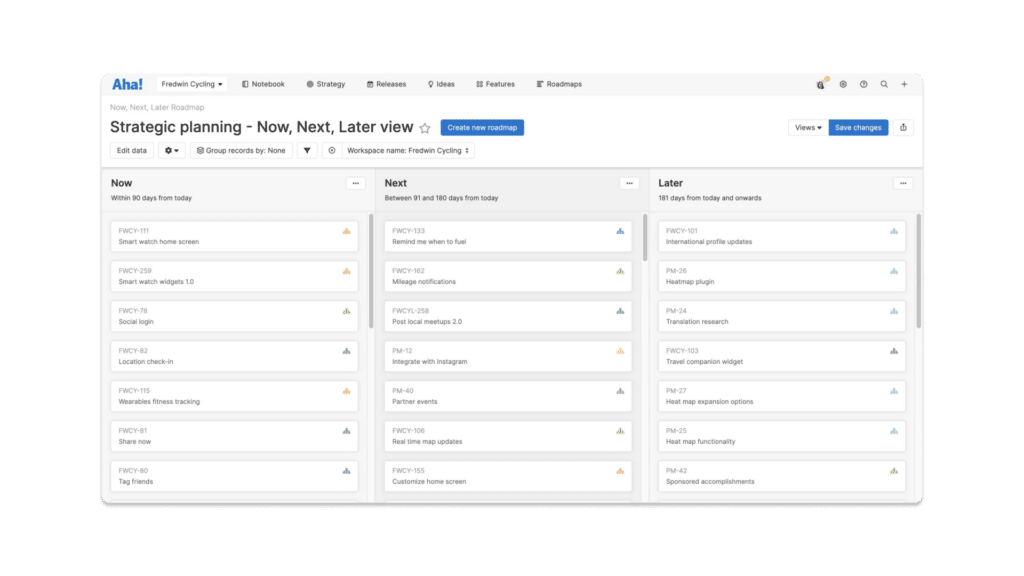
Who is it for?
Aha! is a well-known option for Product Managers working in large organizations. Aha! Is underpinned by a more traditional approach to Product Management so may be better suited to those that approach Product from more of an operational perspective.
Best features – Pros
- Strategy tools: In a similar way to ProdPad, Aha! provides an area for PMs to capture their Personas, Strategy and Vision (although it’s at the overall account level and not sitting next to individual roadmaps). There are also a number of strategic framework tools available as templates to help you do, for example, SWOT analysis.
- Customizable reports: Aha! provides a very customizable suite of reports that enable you to drill down into the data and create analysis into your product process. The customization takes a bit of time to get your head around, but this capability is interesting if you find yourself spending a lot of time crunching numbers in spreadsheets.
Limitations – Cons
- Single item roadmap hierarchy: Even with Aha!’s Now-Next-Later roadmap, there is only a single level hierarchy. This prevents you from capturing the problem area as the Initiative and nesting different ideas within that. That, unfortunately, means you will end up just pushing features around a board view rather than managing a truly agile, lean roadmap.
- No goal management: With Aha! you cannot set and manage specific goals, relevant to each Objective. This means you will be without the SMART goals that will help you understand if you have achieved your Objective.
- Next to no AI: Aha! is yet to release any AI capabilities in their roadmap tool
Pricing
Starts at $74 per user, per month on their monthly plan, however, they do have annual plans available too.
G2 Rating
Get a full, feature-by-feature comparison of ProdPad vs Aha!
3. Productboard
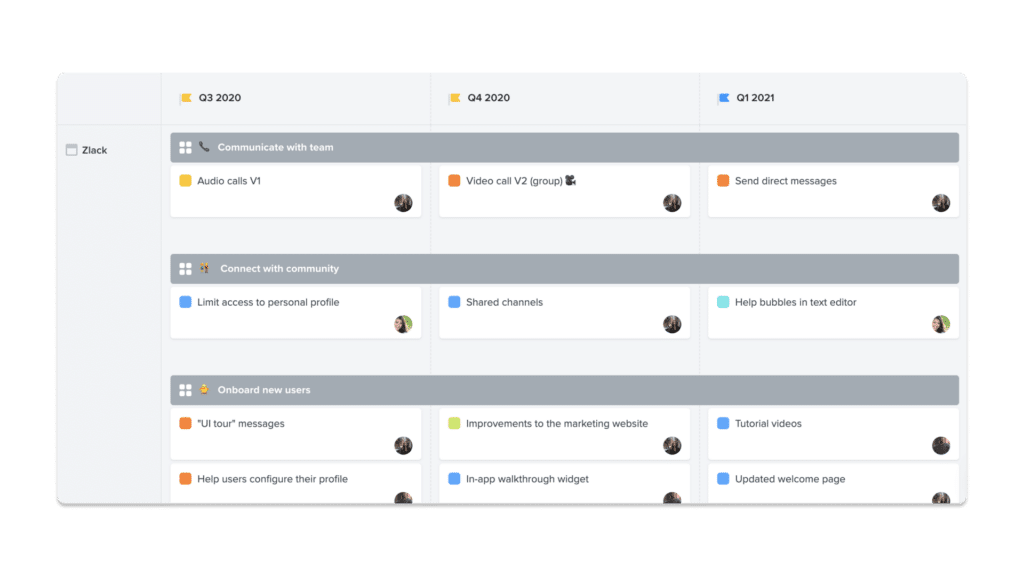
Who is it for?
Productboard is worth considering if you’re looking for a complete platform that will help you manage your roadmap, ideas and customer feedback. The setup is rather complicated but if you think you might need deep customization and configuration Productboard should be on your list. In fact, Productboard can be so complex that the team there offer a professional services level of support that you can purchase to help you grapple with the setup.
Best features – Pros
- Integrations: Productboard have a robust offering of integrations from whiteboarding tools like Miro right through to AI analysis tools like Cobbaï
- User access levels: Productboard, like ProdPad, is another tool that provides you with a lot of control over the access levels and permissions that each of your users has. This can be very important in larger organizations or where sensitive projects may be in play.
Limitations – Cons
- No strategy capture: Productboard does not have an area for you to document product vision, values or add narrative to your product strategy.
- No OKR or goal management tool: Productboard does not offer an in-bulit tool to help you set and track your product objectives making it harder to align your roadmap with priority outcomes.
- Single item roadmap hierarchy: Like Aha!, Productboard only provides a ‘feature board’ by way of a time-horizon based roadmap, preventing you from communicating larger initiatives with multiple features ideas within them.
- Basic reporting: Productboard’s reporting features are minimal, which can limit how well you track progress or demonstrate strategic alignment.
- Complexity: The user interface can feel cluttered and difficult to navigate, and many users complain about the level of decision that have to be made before you can get started.
- AI only available on the highest price plan: The AI assistance that comes with Productboard is only available with the top tier plans, making the tools less integrated or integral to the overall experience.
Pricing
Starts at $19 per user, per month for their Essentials Plan.
G2 Rating
Get a full, feature-by-feature comparison of ProdPad vs Productboard
4. ProductPlan
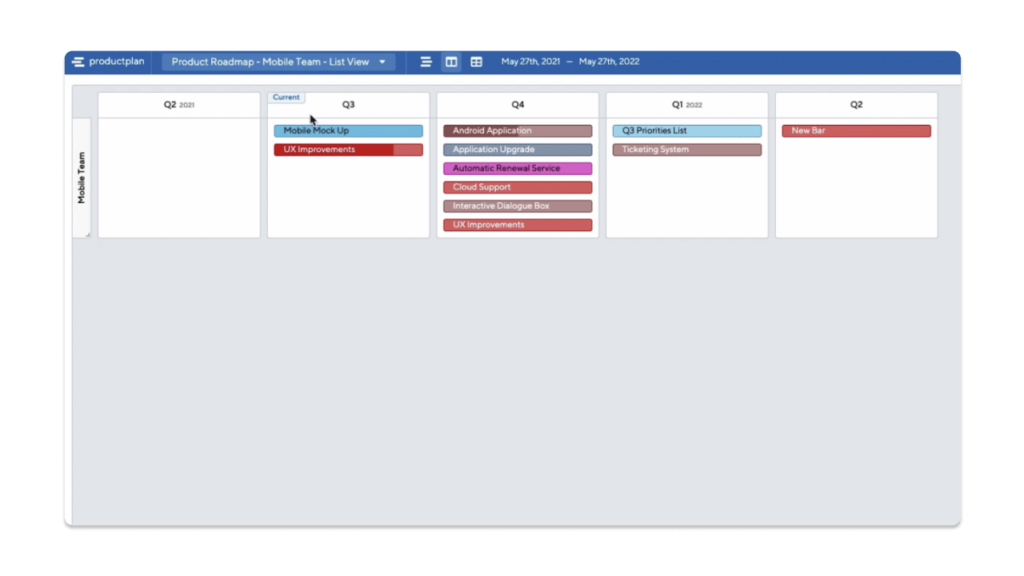
Who is it for?
ProductPlan is a good option for teams that want a super simple, visual tool to present their roadmap.
Best features – Pros
- User-friendly: ProductPlan’s drag-and-drop interface is simple to use and great for teams looking for a quick visual solution.
- Launch project management: ProductPlan also has an adjacent tool for managing launch plans and collaborating with GTM teams. It helps you create and track tasks and assign due dates for the launch phase of a feature release.
- Sharing: Decent for sharing roadmaps with non-technical stakeholders, they allow for easy external link sharing.
- Great resources: ProductPlan has a great resource center to help you navigate your way around the app and tackle general product management problems.
Limitations – Cons
- No customer feedback management: ProductPlan doesn’t have tools to help you collect or prioritize customer feedback.
- No idea management: ProductPlan is a roadmap only tool, so you won’t be able to manage your backlog and easily link ideas and their related documentation to your roadmap items.
- No AI assistance: ProductPlan doesn’t have any AI-powered tools to lighten the load.
Pricing
ProductPlan no longer advert their pricing on their website and seem to be offering custom enterprise packages only that necessitate a call with the Sales Team.
G2 Ratings
5. Roadmunk
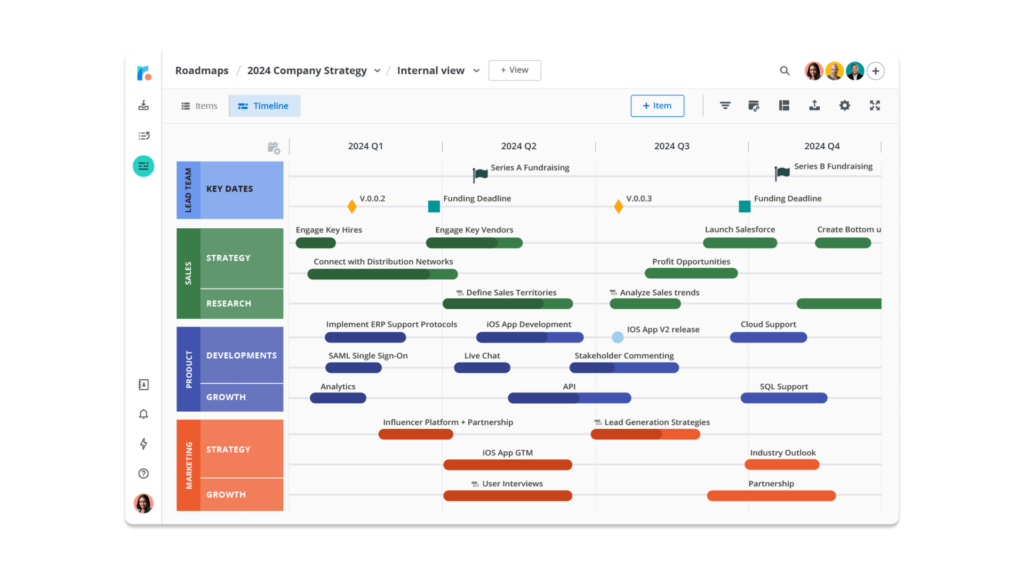
Who is it for?
Roadmunk is a decent option for teams that need flexible roadmap views. If you are forced to balance unwavering stakeholder demands for timelines with a desire to work more flexibly then Roadmunk may be the solution that gives you both avenues.
Best features – Pros
- Multiple views: Offers flexibility in how you display roadmaps, which can be useful if you’re battling with different stakeholder preferences.
- Portfolio level roadmaps: Allowing you to have different levels and roadmap effectively across your organization.
- Prioritization: Provides some fairly robust prioritization features, so you’re able to assess your product ideas against a range of different criteria.
Limitations – Cons
- Limited integrations: There are only two integration options with Roadmunk – one for Jira and the other ADO, meaning you’re going to hit roadblocks when trying to sync data from other platforms like CRMs or Support tools.
- Weaker strategic focus: Roadmunk focuses more on visuals than on providing the tools needed to build a strategy that drives outcomes.
- No Now-Next-Later roadmap: Although you can do a swimlane roadmap, Roadmunk don’t offer a proper Now-Next-Later roadmap format.
- Limited customer feedback management: Roadmunk is primarily a roadmap-only solution but in recent years they have added some basic ways to add feedback into the tool, however they aren’t as robust as other product roadmap tools.
Pricing
Starts at $19 per user, per month. However, this is only for the single user, you’ll need to upgrade to the Business Plan at $49 per month for your team to get access.
G2 Rating
6. Jira Product Discovery
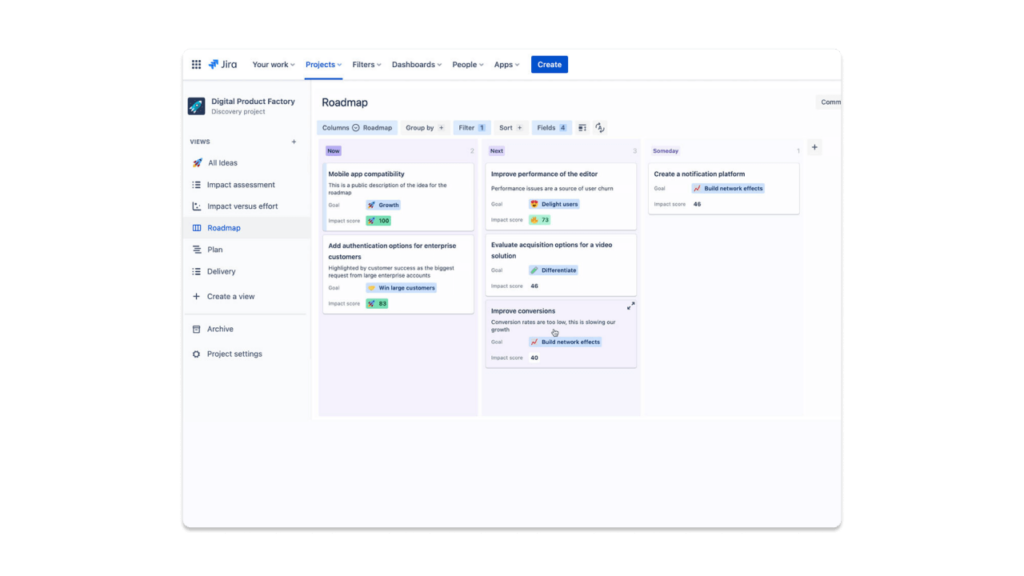
Who is it for?
Jira Product Discovery is best for teams that are already deeply integrated into the Jira ecosystem and are struggling to find budget for a more robust roadmapping solution. Like ProdPad, Jira Product Discovery only facilitates the Now-Next-Later roadmap format so it’s a solid choice if one of your priorities is keeping your team working consistently and in line with best practice.
Best features – Pros
- Easy Jira integration setup: If your team is already using Jira Software for development, the integration here is obviously set as standard. You won’t need to set it up and confirm authorization between the two tools.
- Now-Next-Later customization: Offers flexibility to play with the Now-Next-Later structure and adapt it (although…beware you don’t end up with something that doesn’t fulfill the outcome-focus of a true Now-Next-Later)
Limitations – Cons
- Single level roadmap hierarchy: Like a couple of other contenders on this list, Jira Product Discovery does not allow you to nest Ideas within Initiatives on your roadmap, therefore limiting the flexibility you have to remain agile and adapt to your discovery findings.
- Fewer ways to gather feedback: Although Jira Product Discovery does allow you to capture feedback to inform your roadmap, the tool is missing the integrations that would make this feedback flow consistent and effortless.
- No feedback analysis tools: There are no tools to help you uncover insights from your feedback to inform your product thinking.
- No AI assistance: Jira Product Discovery is yet to offer an AI assistance.
- No roadmap publishing: You cannot publish your roadmap externally meaning all viewers will need to have their own login.
- Lack of collaboration tools: You won’t be able to integrate other communication tools and have your stakeholders contribute to your roadmap planning without actively logging into Jira Product Discovery and using the tool directly.
- Limited standalone value: It’s a good add-on for Jira users but doesn’t stand alone well as a comprehensive product roadmap tool.
Pricing
Starts at $10 per user for teams of 1 – 25
G2 Rating
Oh sorry, Jira Product Discovery isn’t actually represented on G2.
7. Dragonboat
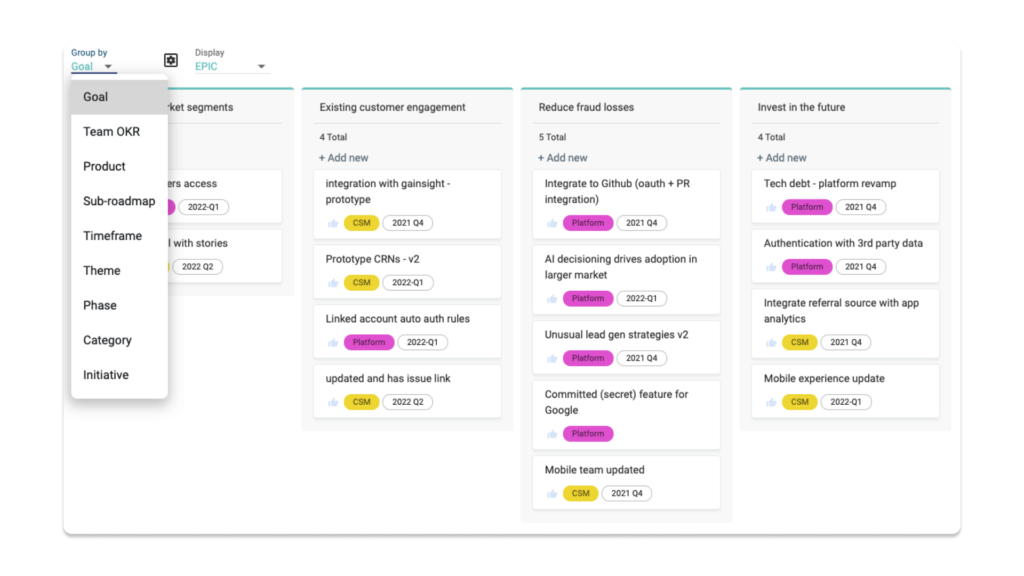
Who is it for?
Dragonboat is a solid choice for large teams managing multiple products or portfolios. It positions itself as a Product Operations platform and has a focus on portfolio decision making and business leadership considerations.
Best features – Pros
- Portfolio management: Great for multi product organizations and portfolio managers looking to make strategic decisions across multiple product lines.
- Outcome-focused planning: It offers good tools for linking initiatives to business objectives.
Limitations – Cons
- Complex interface: Dragonboat’s UI can be difficult to navigate, especially for new users. Users have been known to crumble about the outdated UI.
- Overly robust: The feature set may be too much for teams that aren’t managing portfolios or large-scale product organizations.
Pricing
Dragonboat no longer advertises their pricing publically, you can contact their Sales team directly to discuss options. They have a Standard Plan and a Business Plan available.
G2 Rating
What now?
Think there’s a couple there that could work well for you? The next steps are to book yourself a demo and let the expert teams behind these tools show you how they work in detail. Then you’ll have all the info you need to make the right decision.
Why not start with ProdPad? 😉
See the best product roadmap tool in action

Well-written post! I appreciate how you positioned roadmap tools as enablers of strategic growth rather than just delivery trackers. Exploring a product roadmap example alongside different product roadmap tools makes it easier for teams to see how these frameworks work in real life.
This perspective really helps product leaders make better choices.